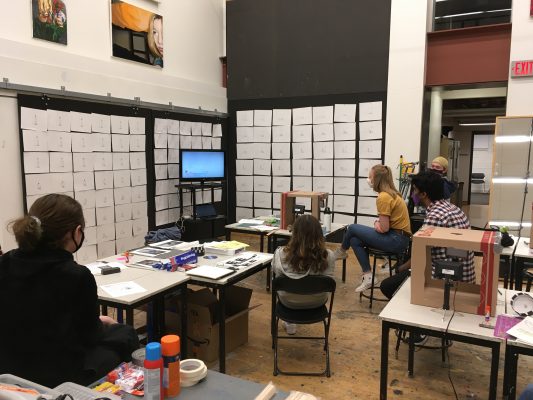August 10, 2021
Cornell College artists are finding new ways to interact with technology as a new professor introduces more digital art courses to the class lineup.
While Digital Art has been taught for the last few years, Assistant Professor of Art Alex McKenzie has added his own expertise to the class.

“The course provides students with a framework for contemporary art practice in which the computer is both a tool and location for creating and experiencing art,” McKenzie said.
During his first year teaching One Course At A Time, he focused about one week of the 3 ½ week block on a program within the Adobe Suite, including Photoshop, Premiere, and Illustrator. He covered concepts such as graphic design, photo manipulation, animation, and video editing.
“You learn really quickly on the block plan,” McKenzie said. “I was impressed at how quickly people went from no experience to a good amount of skills with these programs because they can be quite complicated.”
Senior Ella Fogarty came to Cornell as a transfer student and has enjoyed expanding her knowledge on the topics McKenzie teaches.
“I was really excited that digital art classes were offered, as my previous school only had a limited amount of digital art classes and it is something I’ve always been interested in pursuing,” Fogarty said. “My favorite project was probably a short animation we did in Adobe Photoshop, because I felt like I had a lot of freedom to experiment while also practicing skills we had learned in class.”
Animation is another digital art topic that McKenzie is excited to expand upon at Cornell. In fact, he taught a new course last spring called Advanced Digital Art for the first time. It focused on stop motion and hand drawn animation.
“I really liked doing animation in the classes, and that’s something I’ve been experimenting with more over the summer,” Fogarty said. “I’ve also enjoyed being able to combine the skills I’ve learned in these classes with my previous experience in traditional art, for example hand drawing frames and using Photoshop or another program to sequence them into an animation.”
And these two digital art courses are just the start for the Department of Art and Art History.
“We are currently solidifying course offerings and are working to build a larger curriculum of courses around digital art,” McKenzie said. “Eventually there will be a course entirely dedicated to graphic design and a course dedicated to sound design production, and some courses related to projection art, projection mapping, working with video and installing those in spaces rather than just on the screen.”
Plus, in the future Cornell will have a Mac computer lab on the fourth floor of McWethy Hall for digital art classes and creation.

While these classes and future plans create well rounded artists, these experiences also extend well beyond the fine arts realm into many different careers.
“I think regardless of whether you want to become a fine artist or something else, these are tools of contemporary communication,” McKenzie said. “Business, science, really anything–a lot of these skills can translate into communicating information and ideas that are easily digestible and visually attainable, which I think is important regardless of your field or area of study.”
As for Fogarty, she plans on pursuing a career in the visual arts industry.
“I would love to do something that involves animation or digital illustration,” Fogarty said. “The skills that I’ve learned in these classes are things that I think I will build on as I further pursue this field.”
McKenzie started at Cornell in 2020 and enjoys researching and studying sound design and sound design installation, digital and internet culture, and memetics. He previously taught at Catawba Valley Community College in Hickory, North Carolina, and his work has recently been exhibited at The Mint Museum of Art in (Charlotte, North Carolina), 500X Gallery (Dallas, Texas), and Project 1612 (Peoria, Illinois). He holds an M.F.A. in time-based art from the University of Tennessee at Knoxville.
